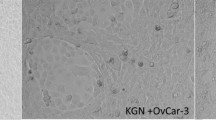Abstract
Purpose: Our purpose was to determine the effects of thecoculture of embryos on human granulosa cells (GCs) inpatients in the first cycle of IVF-ET treatment and in patientswith repeated implantation failures and to investigate thepresence of specific proteins in a 48-hr GC conditionedmedium and the GC ultrastructural characteristics.
Methods: Eighteen patients with tubal or idiopathicinfertility were enrolled in this study: 7 patients (Trial 1) were inthe first cycle of IVF-ET treatment and 11 patients (Trial 2)had repeated implantation failures (one to five). Embryosfrom each patient were cocultured randomly either onhomologous granulosa cells or on a conventional culturemedium.
Results: At the end of the coculture period (day 5 or 6),50% of the embryos (Trial 1) reached the blastocyst stage,with respect to 35% in Trial 2. The pregnancy rate perretrieval was 14.2 and 9%, respectively, in Trial 1 and inTrial 2. Many conditioned media showed proteins of 24–29kDa. and some of them showed additional proteins of 90kDa. The ultrastructural analysis of GCs showed healthy,metabolically active, protein-synthesizing, and mostlysteroidogenic cells.
Conclusions: GC cultures improve embryo development butnot pregnancy rates both in Trial 1 and in Trial 2.
Similar content being viewed by others
REFERENCES
Bongso A, Ng SC, Fong CY, Anandakumar C, Marshall B, Edirisinghe R, Ratnam S: Improved pregnancy rate after transfer of embryos grown in human fallopian tubal cell coculture. Fertil Steril 1992;58(3):569-574.
Jayot S, Parneix I, Verdaguer S, Discamps G, Audebert A, Emperaire JC: Coculture of embryos on homologous endometrial cells in patients with repeated failures of implantation. Fertil Steril 1995;63(1):109-114
Menezo YJR, Sakkas D, Janny L: Co-culture of the early human embryo: Factors affecting human blastocyst formation in vitro. Microsc Res Technique 1995;32:50-56
Wiemer KE, Hoffman DI, Maxson WS, Eager S, Muhlberger B, Fiore I, Cuervo M: Embryonic morphology and rate of implantation of human embryos following co-culture on bovine oviductal epithelial cells. Hum Reprod 1993;8(1):97-101
Ben-Chetrit A, Jurisicova A, Casper RF: Coculture with ovarian cancer cell enhances human blastocyst formation in vitro. Fertil Steril 1996;65(3):664-666
Quinn P, Margalit R: Beneficial effects of coculture with cumutubuli lus cells on blastocyst formation in a prospective trial with supernumerary human embryos. J Assist Reprod Genet 1996;13(1):9-14
Olivennes F, Hazout A, Lelaidier C, Freitas S, Fanchin R, de Ziegler D, Frydman R: Four indications for embryo transfer at the blastocyst stage. Hum Reprod 1994;9(12)2367-2373
Turner K, Lenton EA: The influence of Vero cell culture on human embryo development and chorionic gonadotrophin production in vitro. Hum Reprod 1996;11(9):1966-1974
Freeman MR, Whitworth CM, Hill GA: Granulosa cell co-culture enhances human embryo development and pregnancy rate following in-vitro fertilization. Hum Reprod 1995; 10(2):408-414
Dirnfeld M, Goldman S, Gonen Y, Koifman M, Calderon I, Abramovici H: A simplified coculture system with luteinized granulosa cells improves embryo quality and implantation rates: a controlled study. Fertil Steril 1997;67(1):120-122
Plachot M, Antoine JM, Alvarez S, Firmin C, Pfister A, Mandemature lbaum J, Junca AM, Salat-Baroux J: Granulosa cells improve human embryo development in vitro. Hum Reprod 1993; 8(12):2133-2140
Nottola SA, Familiari G, Micara G, Aragona C, Motta PM: The ultrastructure of cumulus-corona cells at the time of fertilization and early embryogenesis. A scanning and transmission electron microscopic study in an in vitro fertilization program. Arch Histol Cytol 1991;54:145-161
Motta PM, Nottola SA, Pereda J, Croxatto HB, Familiari G: Ultrastructure of human cumulus oophorus: a transmission electron microscopic study on oviductal oocytes and fertilized eggs. Hum Reprod 1995;10:2361-2367
Fabbri R, Porcu E, Lenzi A, Gandini L, Marsella T, Flamigni C: Follicular fluid and human granulosa cell cultures: influence on sperm kinetic parameters, hyperactivation and acrosome reaction. Fertil Steril 1998;69(1):112-117
Laemmly UK: Cleavage of structural proteins during the assembly of head bacteriophage T4. Nature 1970;227:680-685
Merrill CR, Goldman D, Sedman SA, Ebert MH: Science 1981;211:1437-38
Bongso A, Fong CY, Ng SC, Ratnam S: The search for improved in-vitro systems should not be ignored: Embryo coculture may be one of them. Hum Reprod 1993(8):1155-1162
Menezo Y, Guerin JF, Czyba JC: Improvement of human early embryo development in vitro by coculture on monolayers of Vero cells. Biol Reprod 1990;42:301-306
Guerin JF, Mathieu C, Pinatel MC, Regnier-Vigoroux G, Lornage J, Boulieu D, et al.: Coculture d'embryons humains avec des cellules epitheliales de reign de singe: donnes cliniques concernant les transferts a J3 et J5. Contracept Fertil Sex 1991;19:635-638
Van Blerkom J: Development of human embryos to the hatched blastocyst stage in the presence or absence of a monolayer of Vero cells. Hum Reprod 1993;8:1525-1539
Vlad M, Walker D, Kennedy RC: Nuclei number in human enbryos co-cultured with human ampullary cells. Hum Reprod 1996;11(8):1678-1686
Hartshorne GM, Bell SC, Waites GT: Binding proteins for insulin-like growth factors in the human ovary: Identification, follicular flluid levels and immunohistological localization of the 29-32 kD type 1 binding protein, IGF-bp1. Hum Reprod 1990;5(6):649-660
Liu LPS, Chan STH, Ho PC, Yeung WSB: Human oviductal cells produce high molecular weight factor(s) that improves development of mouse embryo. Hum Reprod 1995;10:2781-2786
Zoller LC: Quantitative analysis of the membrana granulosa in developing and ovulatory follicles. In Ultrastructure of the Ovary, G Familiari, S Makabe, PM Motta (eds). Boston, Kluwer Academic, 1991, pp 73-89
Schmidt CL, Kendall JZ, Dandekar PV, Quigley MM, Scmidt KL: Characterization of long-term minolayer cultures of human granulosa cells from follicles of different size and exposed in vivo to clomiphene citrate and HCG. J Reprod Fert 71: 279-287
Author information
Authors and Affiliations
Rights and permissions
About this article
Cite this article
Fabbri, R., Porcu, E., Marsella, T. et al. Human Embryo Development and Pregnancies in an Homologous Granulosa Cell Coculture System. J Assist Reprod Genet 17, 1–12 (2000). https://doi.org/10.1023/A:1009424528177
Issue Date:
DOI: https://doi.org/10.1023/A:1009424528177




